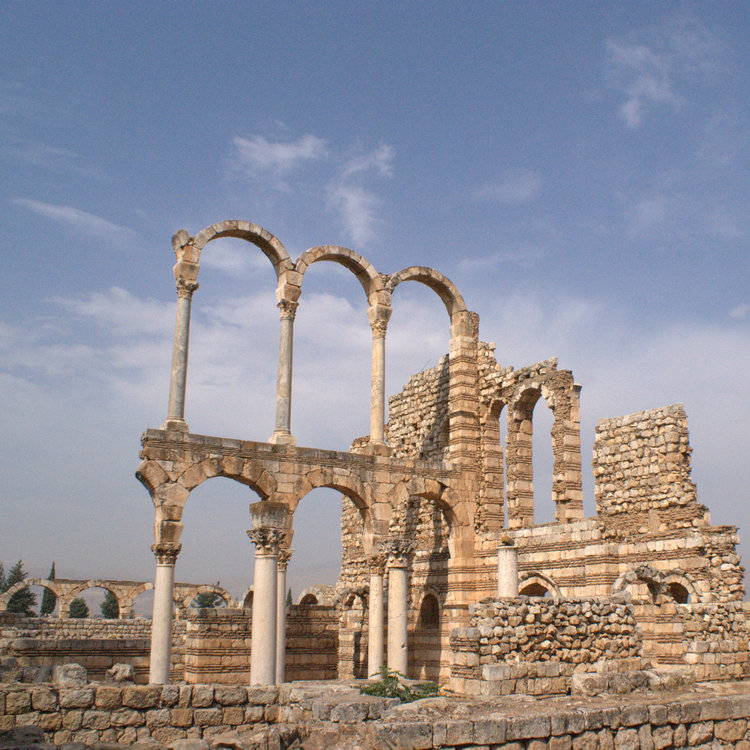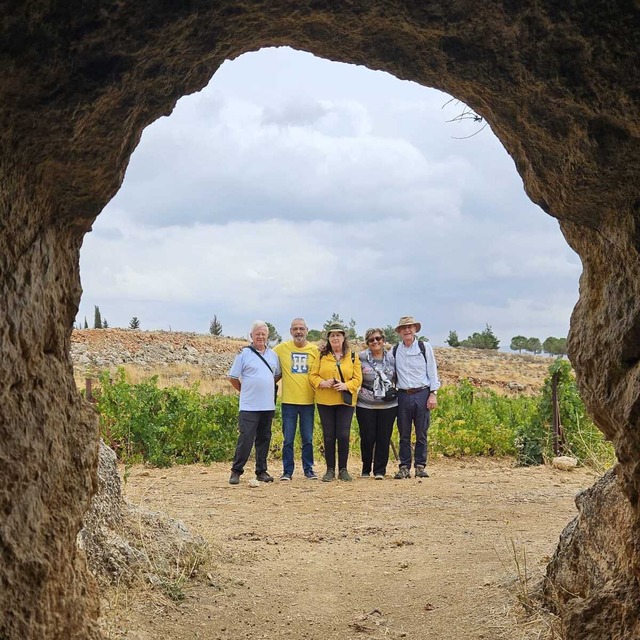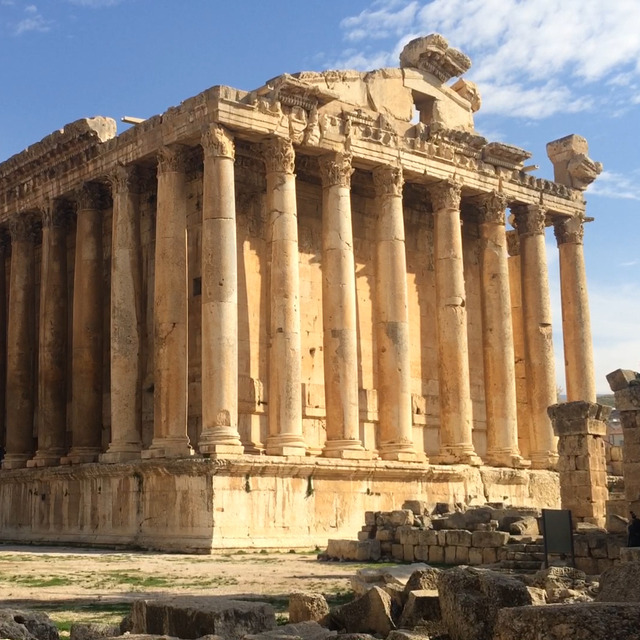
Day 1 : Arrival
Arrive into Beirut Airport where you will be met by a Travel The Unknown representative. Transfer to hotel in Beirut for overnight.
Overnight in The Parisian Hotel, Beirut
Meal plan: n/a
Lebanon offers iconic sites - Baalbek's Roman masterpieces, the remarkable histories and remains of Byblos, Sidon and Tyre, the cavernous Jeita Grotto and the urban cool of Beirut. But it offers so much more. This tours combines these highlights with some lesser visited but equally charming spots in Lebanon.
Ascend 1500-metres into the mountains to find the ruins of Faqra’s Roman temple, explore the countless historical sites, hidden souks and 14th-century mosques of Tripoli, and take in the astounding natural beauty of the Baatara Sinkhole, 160-million years in the making.
Beirut - Jeita Grotto - Faqra - Baalbek - Ksara Winery - Aanjar - Byblos - Tripoli - Sidon - Tyre - Qadisha Valley - Batroun - Baatara sinkhole - Deir el Qamar - Beiteddine - Barouk - Al Shouf Cedar Nature Reserve

Arrive into Beirut Airport where you will be met by a Travel The Unknown representative. Transfer to hotel in Beirut for overnight.
Overnight in The Parisian Hotel, Beirut
Meal plan: n/a

After breakfast, start your sightseeing in Beirut. Visit the Pigeons Rock, the Coastal Avenue, then the city centre where you will find one of the largest reconstruction projects in the world taking place and visit the National Museum. Afterwards, proceed to visit the Jeita Grotto, a beautiful natural wonder, and one of the best caverns in the Middle East. Transfer by cable car to the caverns, which consist of two parts, lower & upper galleries. The lower ones are visited by boat, while the upper caverns on foot. Drive up the mountain to reach Faqra. At about 1500-metres above the sea level stands a Roman temple that is in very good condition. Return to Beirut.
Overnight in The Parisian Hotel, Beirut
Meal plan: Breakfast

After breakfast, depart to visit the Beqaa Valley to reach one of the world’s greatest archaeological sites, the ruins of Baalbek, Lebanon’s greatest Roman treasure, counted amongst one of the wonders of the ancient world. The site includes the temples of Jupiter, Bacchus and Venus, with the remarkable Great Court and the Hexagonal Forecourt. Continue to Ksara winery for a taste of fine Lebanese wine and see how it is produced. Afterwards, visit the historical Omayyad site in Aanjar. In ancient times, it was an important commercial site due to its strategic location in Bekaa. Return to Beirut.
Overnight in The Parisian Hotel, Beirut
Meal plan: Breakfast

After breakfast, depart for Harissa where you will climb by cable car to the Holy statue of Notre Dame for a breath-taking view of Jounieh and Beirut. In the afternoon, proceed to Byblos, the oldest town in the world continuously inhabited for 5,000 years. Visit the city of Byblos, including the Citadel, St John's Church and the old port. Proceed to Tripoli, known as the capital of the north and visit sites in the old part of the city, dating back to the Mamluk and Ottoman eras. Return to hotel in Beirut for overnight.
Overnight in The Parisian Hotel, Beirut
Meal plan: Breakfast

After breakfast, you will start your exploration of southern Lebanon with a visit to Sidon, a vital commercial and administrative centre. Its star is a Crusader Castle overlooking the harbour. The old town is still standing with its alleys and its souks (markets) which have maintained their Middle Age features. Continue to Tyre which was previously an island. The main sites of interest are the Arc de Triomph and the Hippodrome. Return to Beirut.
Overnight in The Parisian Hotel, Beirut
Meal plan: Breakfast

After breakfast, visit Gebran Museum in Bcharreh. Afterwards, visit the Cedars forest that contains around 300 cedar trees. It is a relic and a rare area of woodland that Lebanon was well known for in ancient times. The Canaanites, Egyptians and Phoenicians used cedar wood to build their temples and ships. Continue to the Monastery of St Antonios Qozhaya in the Qadisha Valley, filled with caves and rock shelters inhabited from the 3rd millennium BC to the Roman period, the valley is scattered with cave chapels, hermitages and monasteries cut from rock. Return to hotel in Beirut for overnight.
Overnight in The Parisian Hotel, Beirut
Meal plan: Breakfast

After breakfast, take a morning walking tour of Batroun, known for its Maronite and Greek Orthodox churches and other ancient sites. Continue to visit a pottery workshop in Assia where artisans still hand-make unique local styles of pottery using very traditional practices. Afterwards, proceed to Tannourine, the site of the impressive Baatara Gorge sinkhole & Balaa Gorge waterfall. The waterfall drops 250m into the Baatara Pothole, a cave sculpted out of Jurassic limestone. Return to Beirut.
Overnight in The Parisian Hotel, Beirut
Meal plan: Breakfast

Leave in the morning for Beiteddine, stopping en-route at the village of Deir el Qamar, with its charming buildings dating back to the 17th and 18th centuries. In Beiteddine, take a tour of the fine palace and its museums, which illustrates the best of 19th century Lebanese architecture. The palace enjoys incredible views of the surrounding mountains. After lunch, continue to the Al Shouf Cedar Nature Reserve in Barouk for a leisurely walk enjoying the wilderness. Return to Beirut.
Meal plan: Breakfast

After breakfast, transfer to Beirut airport for your departing flight.
Meal plan: Breakfast
All accommodation subject to availability. Final accommodation choices will be confirmed after booking.

Located a short walk from Beirut’s Mediterranean coastline, just 2km from the city centre’s many cultural sites, and a 15-minute drive from Rafic Hariri International Airport, The Parisian Hotel is conveniently situated to accommodate a range of desires. The hotel’s 46 guestrooms feature modern, homely décor, all modern amenities, a full en-suite with bath and a balcony with cityscape or sea views. During their stay, guests may also enjoy extensive dining options in The Parisian's John Posh Café and a range of convenient services including 24-hour reception and car rental.
Learn recipes, sample delicious mezze and sip on fine wines
Discover Lebanon's panoramic ridges and isolated monasteries by foot
Explore Lebanon's spectacular sinkholes and cave complexes
Experience Lebanon's lofty ski slopes or try your hand at snowshoeing
Roman sites, rich culture and cedar forests
Ancient ruins, natural wonders and the hidden treasures of Lebanon
Discover the flavours of the Levant
Discover ancient history, archaeology & architecture
Discover Phoenician history, sublime ruins & fine wine
Hike through the verdant and historic Qadisha valley
Mary , Hiking the Holy Valleys, LebanonThe Qadisha Valley is a beautiful and fascinating place. The night in the monastery was a highlight for me although both the other home stay nights were equally enjoyable in their own way. Danielle made me feel particularly welcome and my guides looked after me very well throughout.

Joanne Hyde , Essential LebanonGreat mixture of everything. Of all the places we visited, Byblos is a lovely town with great restaurants. Also, the lunch at the Eco place in the Bekka valley was stunning. While it was expensive, Lebanon is an expensive country and we saw more than we could possibly have seen by ourselves. Best holiday in a long while. Travel The Unknown were flexible and professional to deal with and put together a trip for us that was one of the best holidays in years. Would definitely consider Travel The Unknown again for future trips.

Charles Harpum , Essential LebanonThe trip to Lebanon was first class in every way. In the four full days of the tour, we saw all the main sights in the country and some extras were thrown in. The guide and driver were outstanding. The accommodation was good and the food was absolutely superb.

Chris Thompson , Lebanon ExplorerThe Lebanon Explorer visit was a pleasure from start to finish. From a personal and friendly approach to booking to the seamlessly organised and well paced itinerary, the trip was highly memorable. Our guide was always ready to help us to understand the complexities of everyday life in Lebanon as well as providing entertaining information on the rich historical and archaeological sites. For me, the best part was that I didn't feel rushed.

Andrea Nutter , Tailormade LebanonTravel the Unknown is now our travel company of choice. It is really easy to deal with Rahul, the destinations offered are very comprehensive and all aspects of the trips are carefully chosen - itinerary, accommodation, meals etc. Our guides have been superb. They are knowledgeable, helpful, friendly and always happy to suggest tweaks to enhance the experience. The drivers are equally good and willing to go the extra mile - literally too. All in all, a first class company.

Robert Williams , Lebanon ExplorerMost of my 40 years of travelling across the globe has been independent travelling with the occasional exception. My recent organised tour of Lebanon with Travel The Unknown was excellent a diverse and great trip. It was a great way of seeing such a small and wonderfully diverse country in a short time, a truly great place!! Rahul and his team were responsive, knowledgeable and a real pleasure to do business with them. The local guide was excellent and the driver friendly and helpful. I strongly recommend them if they travel to a country you want to see albeit do not want the effort, hassle and planning to travel independently.
